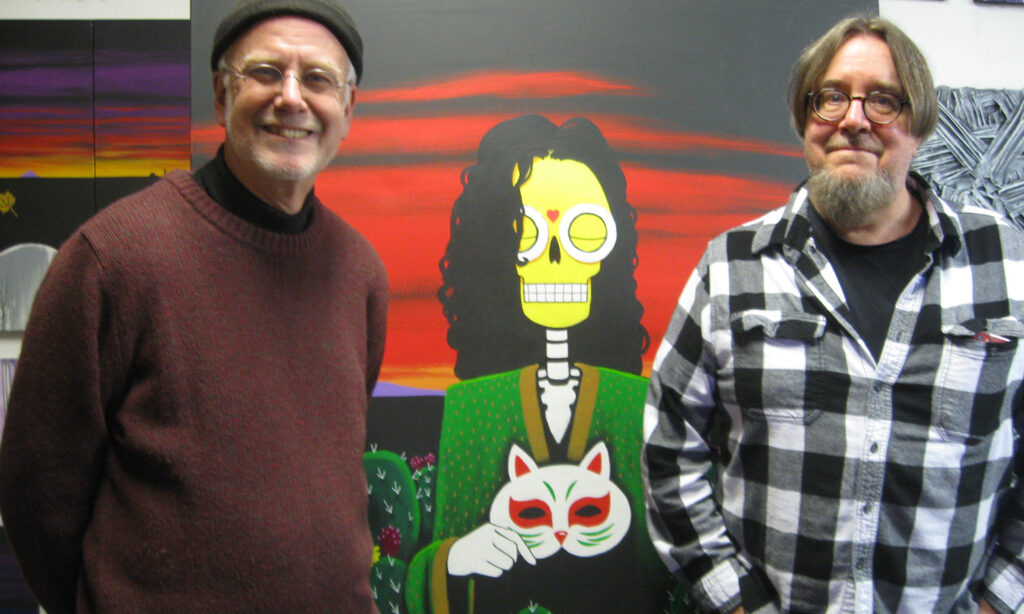
WILLIAMSPORT – Built in the late 1800s, the Pajama Factory is a staple in the Williamsport community and while a variety of updates have brought it into the 21st Century, the factory continues to keep its connection to the past.
Since Mark and Suzanne Winkleman bought the Pajama Factory in 2007, on the corner of Park Avenue and Rose Street, the building has become a gathering place for the creative, unique and artistic. This former factory has been converted into shops, artist studios and lofts while keeping its former industrial aesthetic.
On Dec. 21, 2017, the complex was added to the National Registry of Historic Places.
In March 2020, the factory opened its new elevator to the public, highlighting a modern style, while staying true to the shafts’ old freight car feel.
Thanks to the help of a local elevator company, Port Elevators, and artist Todd Rice, the brand new elevator has been installed with a unique twist. The walls have been painted with black light colors and the car itself outfitted with black lights to give the ascent and descent an ethereal feel.
“I got the idea from a club I was in the 1980s,” Winkelman said. He said the unusual light spectacle stayed with him for decades. When given the opportunity to create such a unique display, Rice was asked to paint and design the shaft interiors.
Winkelman told Webb Weekly, in a Feb. 2018 issue, “This building complex is a cornerstone of the city. We have people visiting the building all the time who speak of their family members who used to work here when it was a manufacturing center.”
“Over $10 million dollars has been invested in the project to date – borrowing from friends and family and then putting every penny back into ongoing upgrades to preserve this wonderful building that is part of the historic fabric of Williamsport. With this, we are starting to also see improvements in the neighborhood,” Winkelman told On the PULSE.
As for the elevator, it was at one time a freight elevator. Rice said before the car was installed, the shaft was painted blue then painted with glowing paint. Spots of white were left to give it an abstract point.
Winkelman said the car was a 7 ½-foot cube that could fit several people. One of the benefits of modern technology is that many buildings have rooms dedicated to running the car and cables. Thanks to portability, the motor is in a box attached to the top of the car, with six cables holding it in place. The shaft itself is about 90 feet tall and travels between five floors – including the roof.
Winkelman said the goal is to one day turn the roof into a rooftop lounge and cafe.
In its history, the Pajama Factory complex first began in the 1880s.
According to an April 10th, 2017 issue of the “Sun Gazette” credit for establishing the Lycoming Rubber Company has been attributed to Samuel Norris Williams. In John Meginness’s “History of Lycoming County,” Williams was born in Williamsport in 1841 on Fourth Street near Cemetery Street.
After attending school in Philadelphia, he returned to Williamsport to run books for a local company. He soon “became interested in the lumber business.” He played a part in the Star mill. He was part of a firm called Williams & Foresman. During the Civil War in the 1860s “his deepest sympathies were with the cause of the Union.”
After the war, he married a local girl and in the 1880s he served on the Williamsport City Council and represented the Sixth District. It was during this time, played his part in Lycoming Rubber Company. Williams would also go on to become the 14th mayor of Williamsport in 1899.
At the age of 69, Williams passed away in 1911. He is interred in Wildwood Cemetery (not far from where he was born) in a crypt created specifically for him.
Both Winkelman and his wife are expecting great things being a part of the community.
“We are incredibly excited about the progress we’ve made in developing this building,” Winkelman said.
The building now houses almost 130 tenants with a mix of artists and other small businesses.
“Leveraging the arts is a proven economic development driver for communities so we are thrilled to provide spaces for artists to do their work and to then enhance the arts offerings to the community at large,” Winkelman said.
He added that “We are excited at how far we have come but even more excited about all we have planned for the future.”
Winkelman believes the complex will be a part of the community for years to come – despite the ups and downs.




